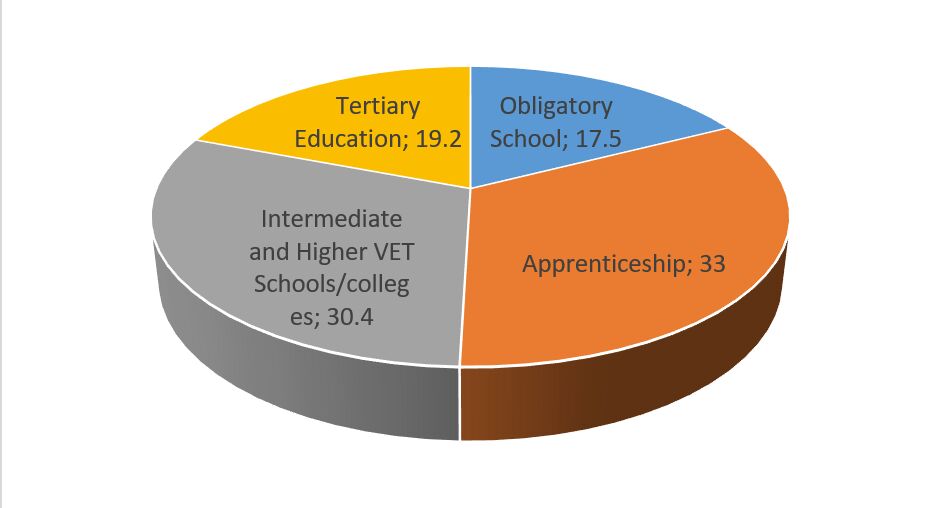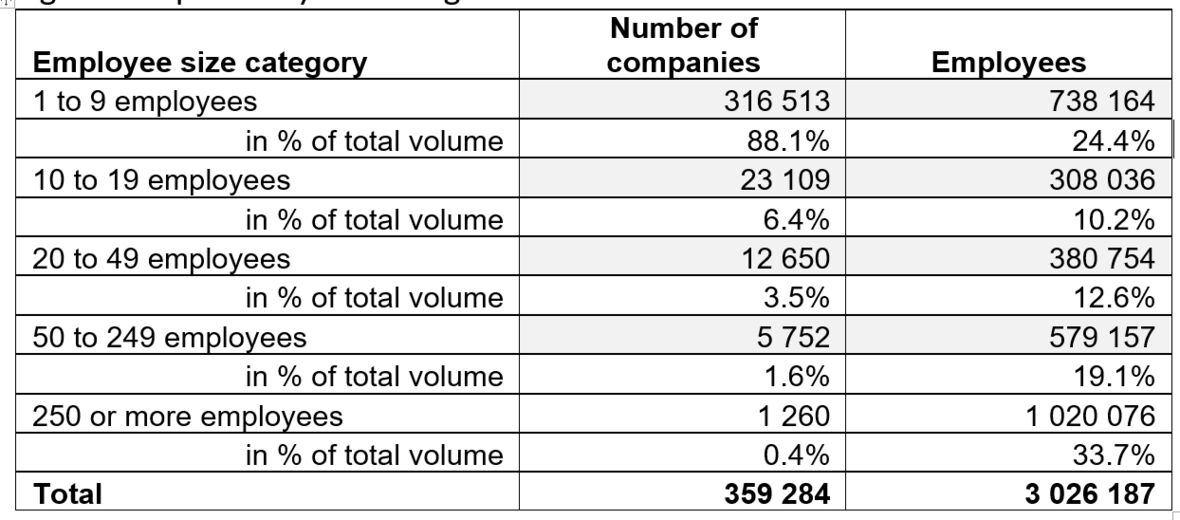Economic Context

Austria is a country of SMEs. SMEs are the central pillar of the Austrian economy. In 2021, there were 358,600 small and medium-sized enterprises, employing more than two million people and employees and training around 52,400 apprentices. They generated more than 60 percent of the sales and gross added value of the economy in Austria.
Working population
Austria’s workforce shows a number of nearly 4,306,000 employees in October 2022 with a total population of nearly nine million (annual average). Both numbers have been increasing steadily in the last years. 68.1% of all women and 76.7% of all men in the age group 15 to 64 years held a job in 2021.
The latest numbers show a decreasing unemployment rate which amounts to 5.1% in October 2022 (international definition), as opposed to 6.0% in the EU-27 (https://www.dnet.at/amis/Datenbank/DB_Eurostat.aspx).
Youth unemployment (15 to 24 years) was 11.5% in 2017 (EU-27: 14.6%, cf. https://www.dnet.at/amis/Datenbank/DB_Eurostat.aspx). Nevertheless, the employment rate of 15- to 24-year-olds was far above the EU-27 average (50.2% compared to 32.7%) in 2021 (cf. https://ec.europa.eu/eurostat/databrowser/view/LFSI_EMP_A__custom_4003654/default/table). This is mainly due to the diversity of vocational education and training (VET) programmes on the upper secondary level, which meet the requirements of the economy.
Sectors of the economy – how well do VET programmes mirror the sectors of economic activity?
Today, the Austrian economy is dominated by services. Around 70% of gross added value comes from the so-called “tertiary” sector. 28,7% comes from the “secondary” sector (production), and 1.3% from agriculture and forestry (the “primary” sector) (cf. https://www.wko.at/service/zahlen-daten-fakten/daten-VGR.html). 73.6% of the labour force is engaged in the service sector (https://www.wko.at/service/zahlen-daten-fakten/daten-arbeitsmarkt-erwerbstaetigkeit-ueberblick.html).
The VET programmes offered in Austria have reacted to this structural change. Curricula of existing programmes have been updated and adjusted, and new programmes have been introduced.
Labour market structure and development – skills levels of the population
In 2021, 33% of the population held an apprenticeship qualification as their highest completed programme (cf. Fig. 1). 30.4% had acquired an upper secondary school-leaving certificate (in a general education or VET programme). 19.2% held a university-level degree. A tendency can be observed that more and more people are acquiring higher-level qualifications.
Fig. 1: Austrian population by highest educational attainment in 2020.

There are clear connections between unemployment rates and educational attainment. In 2021, 4.2% of the workforce with a tertiary qualification were unemployed. 5.0% of apprenticeship graduates were unemployed. The unemployment rate of those with compulsory education only amounted to 14.1% (cf. https://statcube.at/statistik.at/ext/statcube/jsf/tableView/tableView.xhtml).
The relatively low unemployment rate of Austrian youth (15- to 19-year-olds) of 14.6% compared to the EU average of 21.4% in 2021 is mainly due to the vocational programmes at upper secondary level. They are well accepted by young people and the labour market. In addition, many publicly funded youth labour market policy programmes exist (such as the training obligation up to the age of 18).
Business environment, the relative importance of SMEs
In 2020, there were close to 360,000 enterprises in Austria. These companies employed more than 3 million people. The distribution of employees by company size shows the huge importance of SMEs in the Austrian economy. The vast majority (88.1%) of companies employ up to nine people. Overall, about one quarter of the workforce is employed in micro enterprises. Only 0.4% of the Austrian enterprises are large companies (250 employees and more), but 33.7% of all employees work in these companies.
Fig. 2: Companies by size categories in 2020

Regional differences
Even though Austria is a relatively small country, there are differences between the nine provinces in terms of urban/rural characteristics, educational attainment, sectoral characteristics of the economy and the (un)employment rate. Especially Vienna, which is the capital city, is different in many circumstances.